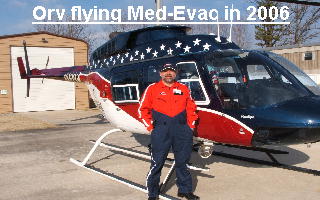| Horizontal Stabilizer
-
The horizontal stabilizer
on the older Rotorways is held onto the steel tube spar by 5each
1/8" aluminum pop rivets on the top surface and five aluminum
rivets on the bottom. These rivets sometimes weaken and can
show signs of coming loose at 60 to 100 flight hours in my experience.
When the helicopter is moved it is natural to grab onto the
horizontal stabilizer as a handle. If you are in the habit of
doing this you will want to inspect these rivets carefully during
your preflight inspection.
-
During forward flight the
air flow over the stabilizer surfaces is substantial and the
forces of the relative wind over the entire surface of the stabilizer
is concentrated onto the narrow line of aluminum pop rivets
along the spar. I have seen several ships where the rivets were
so worn from movement of the skin that several of the rivet
heads were completely missing and the owner was still flying
the helicopter. Obviously the owner was doing a proper preflight
inspection and should have repaired this area before further
flight.
- Several years ago I received a phone call
from a Rotorway owner who had just survived a near-fatal crash
in his Rotorway. He had been flying at altitude when all at
once the nose of the helicopter began to pitch downward and
even with full aft cyclic control input he was not able to bring
the nose of the helicopter up from the steep dive it had entered.
Somehow just before impacting the ground the helicopter hit
a tree which brought the nose of the helicopter up. He hit the
ground hard and survived with injuries. (Here again we see the
crashworthy structure of the Rotorway's heavy frame saving two
lives).
- We surmised that the cause of the nose down
pitch was that the owner designed and installed (not a Rotorway
approved modification) horizontal stabilizer actuator had gone
to nose down pitch rendering the aft cyclic input of the pilot
ineffective in bringing the nose up. I will not fly in a Rotorway
that someone has modified the horizontal stabilizer with this
dangerous trim method.
- If the rivets on your horizontal stabilizer
show wear, you may wish to give that area of your helicopter
some added attention. Here is one method that many have used
to firmly attach the stabilizer skin to the steel spar.
- a. Drill out all 10 aluminum rivets on
each stabilizer(5 on top, 5 on the bottom)
- b. Remove the stabilizer from the spar
by sliding it outboard, de-burr and clean the holes
- c. Mix up blade glue or JB weld and coat
the top and bottom of the steel spar tube with the glue
- d. Slide stabilizer onto spar and line
it up with the original rivet holes
- e. Install steel Cherry Max aviation-grade
rivets dipped into the epoxy and then popped into place,
this bonds the underside of the rivet to the skin so that
there can be no relative movement between them. Be
sure to check the thickness of the metals that you are installing
the new rivets into and order your rivets with the the proper
GRIP LENGTH for the combined thickness
of the metals that you are riveting. The wrong grip length
will not give you a satisfactory bond.
- f. Wipe up excess
- You will now have a very secure attachment
of the stabilizer skin to the spar.
|
| DISCLAIMER:
The material on each page is the opinion of the author
only and any actions taken by the reader relating to information
on this site is the responsibility of the builder. |
|
